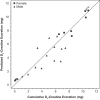Creatine ( methyl-d3) dilution in urine for estimation of total body skeletal muscle mass: accuracy and variability vs. MRI and DXA
- PMID: 28860169
- PMCID: PMC6048459
- DOI: 10.1152/japplphysiol.00455.2016
Creatine ( methyl-d3) dilution in urine for estimation of total body skeletal muscle mass: accuracy and variability vs. MRI and DXA
Abstract
A noninvasive method to estimate muscle mass based on creatine ( methyl-d3) (D3-creatine) dilution using fasting morning urine was evaluated for accuracy and variability over a 3- to 4-mo period. Healthy older (67- to 80-yr-old) subjects ( n = 14) with muscle wasting secondary to aging and four patients with chronic disease (58-76 yr old) fasted overnight and then received an oral 30-mg dose of D3-creatine at 8 AM ( day 1). Urine was collected during 4 h of continued fasting and then at consecutive 4- to 8-h intervals through day 5. Assessment was repeated 3-4 mo later in 13 healthy subjects and 1 patient with congestive heart failure. Deuterated and unlabeled creatine and creatinine were measured using liquid chromatography-tandem mass spectrometry. Total body creatine pool size and muscle mass were calculated from D3-creatinine enrichment in urine. Muscle mass was also measured by whole body MRI and 24-h urine creatinine, and lean body mass (LBM) was measured by dual-energy X-ray absorptiometry (DXA). D3-creatinine urinary enrichment from day 5 provided muscle mass estimates that correlated with MRI for all subjects ( r = 0.88, P < 0.0001), with less bias [difference from MRI = -3.00 ± 2.75 (SD) kg] than total LBM assessment by DXA, which overestimated muscle mass vs. MRI (+22.5 ± 3.7 kg). However, intraindividual variability was high with the D3-creatine dilution method, with intrasubject SD for estimated muscle mass of 2.5 kg vs. MRI (0.5 kg) and DXA (0.8 kg). This study supports further clinical validation of the D3-creatine method for estimating muscle mass. NEW & NOTEWORTHY Measurement of creatine ( methyl-d3) (D3-creatine) and D3-creatinine excretion in fasted morning urine samples may be a simple, less costly alternative to MRI or dual-energy X-ray absorptiometry (DXA) to calculate total body muscle mass. The D3-creatine enrichment method provides estimates of muscle mass that correlate well with MRI, and with less bias than DXA. However, intraindividual variability is high with the D3-creatine method. Studies to refine the spot urine sample method for estimation of muscle mass may be warranted.
Keywords: creatine; creatinine; dual-energy X-ray absorptiometry; lean mass; muscle mass.
Figures





Similar articles
-
Total body skeletal muscle mass: estimation by creatine (methyl-d3) dilution in humans.J Appl Physiol (1985). 2014 Jun 15;116(12):1605-13. doi: 10.1152/japplphysiol.00045.2014. Epub 2014 Apr 24. J Appl Physiol (1985). 2014. PMID: 24764133 Free PMC article.
-
Dilution of oral D3 -Creatine to measure creatine pool size and estimate skeletal muscle mass: development of a correction algorithm.J Cachexia Sarcopenia Muscle. 2018 Jun;9(3):540-546. doi: 10.1002/jcsm.12278. Epub 2018 Apr 16. J Cachexia Sarcopenia Muscle. 2018. PMID: 29663711 Free PMC article.
-
Strong Relation Between Muscle Mass Determined by D3-creatine Dilution, Physical Performance, and Incidence of Falls and Mobility Limitations in a Prospective Cohort of Older Men.J Gerontol A Biol Sci Med Sci. 2019 May 16;74(6):844-852. doi: 10.1093/gerona/gly129. J Gerontol A Biol Sci Med Sci. 2019. PMID: 29897420 Free PMC article.
-
D3 -Creatine dilution and the importance of accuracy in the assessment of skeletal muscle mass.J Cachexia Sarcopenia Muscle. 2019 Feb;10(1):14-21. doi: 10.1002/jcsm.12390. Epub 2019 Mar 21. J Cachexia Sarcopenia Muscle. 2019. PMID: 30900400 Free PMC article. Review.
-
D3 -creatine dilution for skeletal muscle mass measurement: historical development and current status.J Cachexia Sarcopenia Muscle. 2022 Dec;13(6):2595-2607. doi: 10.1002/jcsm.13083. Epub 2022 Sep 5. J Cachexia Sarcopenia Muscle. 2022. PMID: 36059250 Free PMC article. Review.
Cited by
-
Novel Algorithm to Estimate Fat-Free Muscle Volumes in Women Using the Urinary Deuterated-Creatine Dilution Method.J Cachexia Sarcopenia Muscle. 2025 Aug;16(4):e13872. doi: 10.1002/jcsm.13872. J Cachexia Sarcopenia Muscle. 2025. PMID: 40631502 Free PMC article.
-
Biomarkers and the quadriceps femoris muscle architecture assessed by ultrasound in older adults with heart failure with preserved ejection fraction: a cross-sectional study.Aging Clin Exp Res. 2022 Oct;34(10):2493-2504. doi: 10.1007/s40520-022-02189-7. Epub 2022 Aug 8. Aging Clin Exp Res. 2022. PMID: 35939260 Free PMC article. Clinical Trial.
-
Effect of Anamorelin, a Ghrelin Receptor Agonist, on Muscle and Bone in Adults With Osteosarcopenia.J Clin Endocrinol Metab. 2024 Feb 20;109(3):e945-e955. doi: 10.1210/clinem/dgad702. J Clin Endocrinol Metab. 2024. PMID: 38057159 Free PMC article.
-
The Association of Muscle Mass Measured by D3-Creatine Dilution Method With Dual-Energy X-Ray Absorptiometry and Physical Function in Postmenopausal Women.J Gerontol A Biol Sci Med Sci. 2021 Aug 13;76(9):1591-1599. doi: 10.1093/gerona/glab020. J Gerontol A Biol Sci Med Sci. 2021. PMID: 33475725 Free PMC article.
-
Sarcopenia: revised European consensus on definition and diagnosis.Age Ageing. 2019 Jan 1;48(1):16-31. doi: 10.1093/ageing/afy169. Age Ageing. 2019. PMID: 30312372 Free PMC article.
References
-
- Baracos V, Caserotti P, Earthman CP, Fields D, Gallagher D, Hall KD, Heymsfield SB, Müller MJ, Rosen AN, Pichard C, Redman LM, Shen W, Shepherd JA, Thomas D. Advances in the science and application of body composition measurement. JPEN J Parenter Enteral Nutr 36: 96–107, 2012. doi:10.1177/0148607111417448. - DOI - PMC - PubMed
-
- Bianchi L, Ferrucci L, Cherubini A, Maggio M, Bandinelli S, Savino E, Brombo G, Zuliani G, Guralnik JM, Landi F, Volpato S. The predictive value of the EWGSOP definition of sarcopenia: results from the InCHIANTI study. J Gerontol A Biol Sci Med Sci 71: 259–264, 2016. doi:10.1093/gerona/glv129. - DOI - PMC - PubMed
Publication types
MeSH terms
Substances
Grants and funding
LinkOut - more resources
Full Text Sources
Other Literature Sources
Molecular Biology Databases

